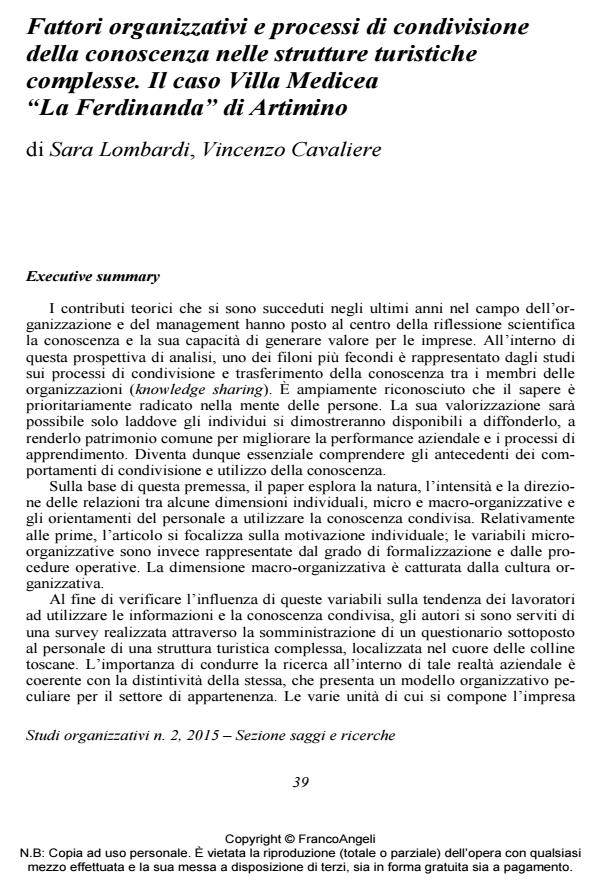Fattori organizzativi e processi di condivisione della conoscenza nelle strutture turistiche complesse. Il caso Villa Medicea "La Ferdinanda" di Artimino
Titolo Rivista STUDI ORGANIZZATIVI
Autori/Curatori Sara Lombardi, Vincenzo Cavaliere
Anno di pubblicazione 2016 Fascicolo 2015/2
Lingua Italiano Numero pagine 35 P. 39-73 Dimensione file 305 KB
DOI 10.3280/SO2015-002002
Il DOI è il codice a barre della proprietà intellettuale: per saperne di più
clicca qui
Qui sotto puoi vedere in anteprima la prima pagina di questo articolo.
Se questo articolo ti interessa, lo puoi acquistare (e scaricare in formato pdf) seguendo le facili indicazioni per acquistare il download credit. Acquista Download Credits per scaricare questo Articolo in formato PDF

FrancoAngeli è membro della Publishers International Linking Association, Inc (PILA)associazione indipendente e non profit per facilitare (attraverso i servizi tecnologici implementati da CrossRef.org) l’accesso degli studiosi ai contenuti digitali nelle pubblicazioni professionali e scientifiche
I contributi teorici che si sono succeduti negli ultimi anni nel campo dell’organizzazione e del management hanno posto al centro della riflessione scientifica la conoscenza e la sua capacità di generare valore per le imprese. All’interno di questa prospettiva di analisi, uno dei filoni più fecondi è rappresentato dagli studi sui processi di condivisione e trasferimento della conoscenza tra i membri delle organizzazioni (knowledge sharing). È ampiamente riconosciuto che il sapere è prioritariamente radicato nella mente delle persone. La sua valorizzazione sarà possibile solo laddove gli individui si dimostreranno disponibili a diffonderlo, a renderlo patrimonio comune per migliorare la performance aziendale e i processi di apprendimento. Diventa dunque essenziale comprendere gli antecedenti dei comportamenti di condivisione e utilizzo della conoscenza. Sulla base di questa premessa, il paper esplora la natura, l’intensità e la direzione delle relazioni tra alcune dimensioni individuali, micro e macroorganizzative e gli orientamenti del personale a utilizzare la conoscenza condivisa. Relativamente alle prime, l’articolo si focalizza sulla motivazione individuale; le variabili micro-organizzative sono invece rappresentate dal grado di formalizzazione e dalle procedure operative. La dimensione macro-organizzativa è catturata dalla cultura organizzativa. Al fine di verificare l’influenza di queste variabili sulla tendenza dei lavoratori ad utilizzare le informazioni e la conoscenza condivisa, gli autori si sono serviti di una survey realizzata attraverso la somministrazione di un questionario sottoposto al personale di una struttura turistica complessa, localizzata nel cuore delle colline toscane. L’importanza di condurre la ricerca all’interno di tale realtà aziendale è coerente con la distintività della stessa, che presenta un modello organizzativo peculiare per il settore di appartenenza. Le varie unità di cui si compone l’impresa svolgono attività significativamente distinte, rendendo critica la necessità di integrare conoscenze e informazioni differenziate. L’analisi dei dati raccolti dimostra che i soggetti motivati da fini connessi alla reputazione e allo status tendono ad essere meno orientati verso comportamenti di utilizzo della conoscenza condivisa. Tuttavia, tale relazione negativa può essere mitigata se l’impresa è caratterizzata da una cultura organizzativa che enfatizza la coesione sociale, il lavoro di squadra ed il commitment. Le dimensioni del job design analizzate, infine, evidenziano che, da un lato, la formalizzazione del lavoro è tale da facilitare la messa in pratica di conoscenza condivisa, dall’altro, che la presenza di procedure e regole tende, viceversa, a ridurre tali comportamenti. Coerentemente con l’evidenza empirica emersa, lo studio suggerisce alcune linee guida su cui i manager possono riflettere per lo svolgimento del loro compito di coordinamento e valorizzazione delle risorse.
Parole chiave:Condivisione di conoscenza, motivazione, cultura di comunità, formalizzazione, procedure operative, management del turismo
Sara Lombardi, Vincenzo Cavaliere, Fattori organizzativi e processi di condivisione della conoscenza nelle strutture turistiche complesse. Il caso Villa Medicea "La Ferdinanda" di Artimino in "STUDI ORGANIZZATIVI " 2/2015, pp 39-73, DOI: 10.3280/SO2015-002002